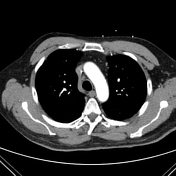9,364 results found
Article
Tuberculosis
Tuberculosis (commonly abbreviated to TB, short for tubercle bacillus) encompasses an enormously wide disease spectrum affecting multiple organs and body systems predominantly caused by Mycobacterium tuberculosis. A small proportion can also be caused by Mycobacterium bovis through drinking unpa...
Case
Pulmonary artery pseudoaneurysms and necrotizing pneumonia

Published
20 May 2024
95% complete
CT
Question
Question 3012
Which of the following favors a non-usual interstitial pneumonia (non-UIP) diagnosis?
Question
Question 3011
Which of the following is most suggestive of a nonspecific interstitial pneumonia (NSIP) pattern of lung fibrosis on HRCT?
Question
Question 3010
Which of the following is an HRCT requirement of the typical usual interstitial pneumonia (UIP) pattern?
Case
Aberrant right subclavian artery with Kommerell diverticulum

Published
19 May 2024
95% complete
CT
Article
Eosinophilic granulomatosis with polyangiitis
Eosinophilic granulomatosis with polyangiitis (EGPA), previously known as Churg-Strauss syndrome is characterized by asthma, eosinophilia and small vessel necrotizing vasculitis and involves the lungs and other organs.
Epidemiology
The incidence typically peaks in middle age, 30-50 years of ag...
Article
Cystic fibrosis
Cystic fibrosis (CF), also called mucoviscidosis, is an autosomal recessive genetic disease that affects the exocrine function of the lungs, liver, pancreas, small bowel, sweat glands, and urogenital system.
This article is a general discussion of the disease. Each organ system are discussed se...
Article
Chest radiograph
The chest radiograph (also known as the chest x-ray or CXR) is anecdotally thought to be the most frequently-performed radiological investigation globally although no published data is known to corroborate this. UK government statistical data from the NHS in England and Wales shows that the ches...
Article
Bronchial triangle sign
The bronchial triangle sign is a CT feature that been proposed to aid differentiation of a pulmonary hamartoma from a peripheral pulmonary carcinoid. It may be present in both but is thought be more frequent in the latter (i.e. peripheral pulmonary carcinoids) and may seen as triangular-shaped r...
Case
Tension pneumothorax (annotated signs)

Published
21 Dec 2019
88% complete
X-ray
Annotated image
Case
Dysphagia lusoria - aberrant right subclavian artery

Published
12 May 2010
66% complete
Barium
Annotated image
Case
Kartagener syndrome

Published
18 May 2024
73% complete
CT
Article
Thalassemia
Thalassemia is an autosomal recessive hemoglobinopathy that originated in the Mediterranean region. The genetic defect causes a reduction in the rate of globin chain synthesis which causes the formation of abnormal hemoglobin molecules. The resultant microcytic anemia is the characteristic prese...
Article
Aflatoxins
Aflatoxins are naturally-occurring mycotoxins that are produced by Aspergillus species, especially Aspergillus flavus. They are acutely toxic and carcinogenic.
Acute exposure
High-level aflatoxin exposure can result in acute aflatoxicosis with acute hepatic necrosis, leading to cirrhosis, and ...
Article
Pulmonary hypoplasia
Pulmonary hypoplasia refers to underdevelopment of one or both lungs. This can be rapidly fatal at birth or mild, escaping detection for decades. It is most often secondary to congenital abnormalities that either restrict intrathoracic space or alter pulmonary fluid dynamics.
Epidemiology
Pulm...
Article
Methotrexate induced pneumonitis
Methotrexate induced pneumonitis is characterized by interstitial inflammation of the lung parenchyma which can be life-threatening. Methotrexate induced pneumonitis falls under a subtype under the broader category of methotrexate induced lung disease.
Diagnosis of methotrexate-induced pneumoni...
Article
Aspergilloma
Aspergillomas are mass-like fungus balls (mycetomas) typically composed of Aspergillus fumigatus and are a non-invasive form of pulmonary aspergillosis. They usually fall under the subgroup chronic pulmonary aspergillosis.
Epidemiology
Aspergillomas occur in patients with normal immune status ...
Case
CPR injuries with incidental lung cancer

Published
19 May 2024
92% complete
CT
Nuclear medicine
Article
Honeycombing (lungs)
Honeycombing is a CT imaging descriptor referring to clustered cystic air spaces (between 3 and 10 mm in diameter, but occasionally as large as 2.5 cm) that are usually subpleural, peripheral, and basal in distribution. They can be subdivided into:
microcystic honeycombing
macrocystic honeycom...









 Unable to process the form. Check for errors and try again.
Unable to process the form. Check for errors and try again.